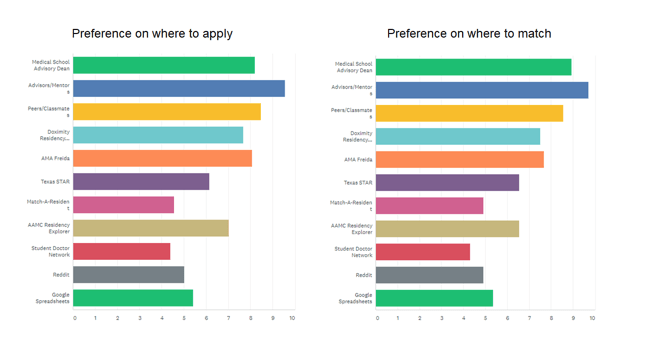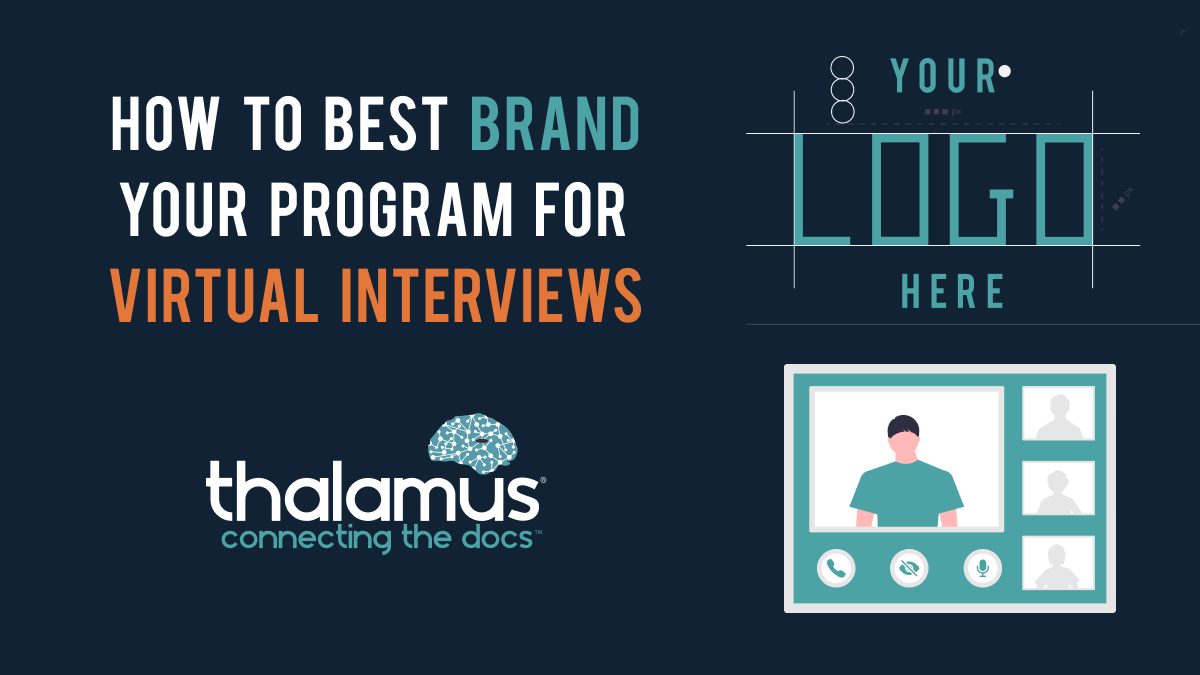In the response to COVID-19, the AAMC/ERAS, The Coalition of Physician Accountability and various specialty organizations including Pediatrics (APPD) and OB-GYN (APGO), are recommending virtual interviews for the 2020-2021 ERAS Residency application season. While several states are preparing to or have re-opened this week, it appears that in-person interviews will be significantly limited for this application cycle. Therefore, reliance on virtual interviews will be paramount. The big question, of course, for residency programs will be, “How do we best brand our program through virtual interviews?”
While medicine at times excludes itself from topics more common to mainstream corporate America, branding is an important concept that spans all industries. It can be thought of as marketing your program or showing candidates “Why our program is awesome.”
According to Entrepreneur.com “Your brand is your promise to customers.” Or in this case, your brand is your promise to potential incoming trainees. It tells them what they can expect by training at your program and the characteristics that differentiate your program from others. Your brand is derived from who you are, who you want to be, and who people perceive you to be.
Your program’s brand is usually defined by a mission statement. Perhaps it is “To train the future leaders of medical education.” or “To educate empathetic physicians to care for our region’s most vulnerable patient populations.” Brands come in different flavors, and certain brands connect differently with various individuals.
A brand can be quite powerful. In fact, Forbes keeps a list of the “World’s Most Valuable Brands.” In viewing the list, most would not be surprised that the top 5 brands are Apple, Google, Microsoft, Amazon and Facebook. At number 6 is Coca-Cola, and this should mean something because the sixth most valuable brand in the world is sweetened carbonated water, and it is worth $59.2B!!!! ‘
While residency programs are not selling a product (at least in the traditional sense), they are selling a brand of training, an experience and an identity for their residents. Trainees will also rely on this brand to apply competitively for fellowships or for their first job upon graduation from residency. They’ll also be attached to your brand throughout their careers and it will affect their earnings, job prospects and ultimately their interactions with patients.
So, crack open an ice cold Coca-Cola and let’s dive into this week’s blog topic! And the fact that you likely now just imagined a Coca-Cola commercial, with the drops of water dripping down an ice cold bottle, should tell you something about the power of branding.
Why Brand Matters in GME.
It is no secret that medical students are both very smart and markedly competitive. They played the academic game, trying to get into the best college in order to get into the best medical school, to now get into the best residency program, in order to become the best doctor possible. While the number of applications per candidate has risen sharply over the last decade to an average of ~60 per domestic graduate and ~150 per international medical graduate (IMG), most to all candidates have particular Top 5 programs they are targeting. And the majority of this is based on brand.
How GME has branded in the past.
An applicant’s first point of contact with a residency program’s brand has traditionally been the program’s website or recommendations from advisors/mentors. Recently, social media has become popular amongst programs as well and has even been studied in the medical literature.
Of course, the in-person interview day itself has been the major vehicle for which a program has historically promoted its brand. This included interactions with residents and faculty, including the Department Chair, Program Director and Program Coordinator. Several programs provide tours of the hospital and the local area.
Others try to compete in swag by providing applicants with pens, mugs, thermoses, bags, stress balls, etc. Others offer swanky interview dinners at fabulous restaurants. Some programs brag about their city’s professional sports team, while others talk up their town’s flashy supermarket.
If you build in clinical training and research opportunities, global health experiences, comfort of beds in the call room and program support for their residents, then voila! Your program has a brand (whether you realized it before or not!). And this is what applicants are assessing on their interview days– “What kind of physician will I become if I train here? Will it help me achieve my career goals?”
How a residency program’s brand is measured.
In general, brand awareness is usually measured by one of several methods including, but not limited to: consumer surveys, website traffic, search volume data, and social listening (i.e. How many people are talking to others about your brand already?). One can measure brand by looking at “volume of mentions” (e.g. number of times your program is mentioned online), “reach” (e.g. how many people will see those mentions or speak of your program regionally, nationally, etc.), and engagement (e.g. How many people are doing something based on what they observe regarding your program). Similarly, in a more GME-specific sense, number of applications, interview completion rates, number of candidates ranking your program highly, number of times applicants mention your program on social media or online sites, and many other metrics can be used to measure your program’s brand.
Interestingly, the NRMP conducts an applicant survey to determine key factors that applicants consider in selecting both programs at which to 1) interview and 2) match. In the 2019 survey, the top 3 categories for US Seniors by percent of respondents citing each factor and average importance rating respectively for selecting programs for application include:
- Desired geographic location (88%, 4.5/5)
- Perceived goodness of fit (84%, 4.7/5)
- Reputation of program (83%, 4.2/5)
The top 3 categories for the same study population for ranking programs include:
- Overall goodness of fit (89%, 4.8/5)
- Interview Day Experience (82%, 4.6/5)
- Desired Geographic Location (77%, 4.6/5)
Similar results are also seen for IMGs, and interestingly, were also the top categories on the prior survey completed in 2017.
Additionally, over the last several years, Doximity’s Residency Navigator has listed program reputation rankings using the following methodology. The rankings have been both studied and scrutinized extensively throughout the medical literature, including here, here and here. However, it has undoubtedly played a significant impact in influencing program brand and, as a result, candidate application, interview and match choices.
Finally, each season, Thalamus conducts an End of Season Survey. In our most recent survey (2020), candidates were asked to rank resources in terms of preferences on: 1) where to apply and 2) where to match. To date, the results are as follows (n = 8,967, ~45% response rate). Note: The longer the bar, the more preferred the resource.

All in all, there are many measures of a program’s brand, and interestingly, while the online resources are heavily talked about as being influential, candidates are reporting that mentors/advisors, deans and classmates play a more significant role in helping them establish an understanding of a residency program’s brand.
What to consider in order to best brand your program for virtual interviews.
In light of COVID-19, programs will likely lose their ability to brand their program in-person and therefore must transition these efforts from an in-person interview day to those that can be done at a distance. The overall keys points to this are that the brand message be easily identifiable, consistent and tangible for candidates.
This means that now more than ever, it is important for program leadership to determine which messages they want to convey to applicants, how they will convey these messages to applicants in a unified sense, and how well candidates will receive and believe these messages. You may very well want to brand your program as the BEST PROGRAM IN THE COUNTRY! But it won’t have much value unless candidates also believe it.
Virtual interviews will change the way the candidates assess the top NRMP criteria including overall goodness of fit, interview day experience, desired geographic location and reputation of program. At the very least, your program should have a strategy that highlights each of these four categories.
Additionally, other categories including quality of residents in the program, quality of faculty/program director, quality of educational curriculum, work/life balance, house staff morale, diversity of patient problems, quality of hospital facilities, call schedule, opportunity to conduct research, salary, cost of living and size of program will also be assessed by applicants. The key will be to communicate these clearly from a distance.
And, of course, candidates will still do their research using the large number of available resources online.
How to best brand your program for virtual interviews.
This will be most critical for the upcoming 2020-2021 application season. We strongly recommend program leadership come together, solidify a mission statement and overall brand to portray to candidates. And then ensure consistent messaging of that brand on your program’s website, in your interview invitation and other interview-specific communications, during the interview day itself, post interview day and through to the Match.
Candidates attending your program should be able to recognize this brand as easily as possible. We recommend asking questions about brand in your post interview and post-match surveys as well. Indeed, one benefit of COVID-19 is that it is a unique time for your programs to innovate themselves and propose a new brand image. So, in planning out your interview season, think about things you’ve always wanted to do with recruitment but never attempted because, “What we were doing was working.”
For instance, in choosing your video conferencing solution, how will you provide candidates with not only the best experience operationally, but how will your virtual interviews distinguish themselves from the many other Zoom, Teams or Webex interviews a candidate will have this season? Perhaps you can use a unique digital background? Should you or should you not include your hospital logo or colors? Will the program buy faculty members better microphones and spotlights to ensure optimal video conferencing conditions? Maybe all faculty members could undergo mock interview training and then plan to wear the same color shirt? Or something even more creative?
In an era where many are social distancing and stuck at home, strategies that play to our humanity will likely be a nice touch (how kitsch you want to make it is up to you and your program 😊). If your program has a sense of humor, show it. If your program has world renowned researchers, show it. If your program has a great group of residents, show that too!
For each component of your interview day, from resident social gathering to noon conference, try to identify how you can each best show off your residency program’s brand from a distance. Swag and thank you notes should undergo the same scrutiny, although be sure any post interview communication abides by NRMP guidelines and policies.
In summary, at a time when candidates are unable to travel to your hospital, how can you show off your program’s unique flare while providing the most memorable interview day experience?
- Recognize the importance of branding in both GME and beyond.
- Solidify your program’s brand on all application and interview day materials and experiences.
- Communicate this to your entire program including residents, faculty, and other staff.
- Recognize those items and topics that are most important to candidates.
- Execute flawlessly and memorably.
Best of luck this interview season!
And finally, Thalamus is excited to assist with virtual interviews this season. In fact, Thalamus will be more equipped than ever to help your program market its brand from a distance including embedded videos/virtual tours, document sharing, custom program logos/photos, video interviews, streamlined and automated itinerary creation for applicants and faculty, social media integration and more! Learn more about Thalamus’ new virtual interview features here or setup a free demo here.
